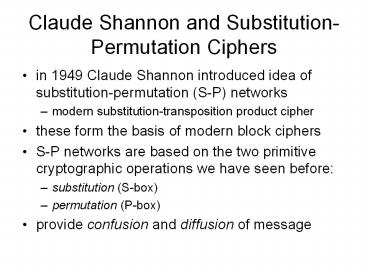Claude Shannon and Substitution-Permutation Ciphers PowerPoint PPT Presentation
1 / 22
Title: Claude Shannon and Substitution-Permutation Ciphers
1
Claude Shannon and Substitution-Permutation
Ciphers
- in 1949 Claude Shannon introduced idea of
substitution-permutation (S-P) networks - modern substitution-transposition product cipher
- these form the basis of modern block ciphers
- S-P networks are based on the two primitive
cryptographic operations we have seen before - substitution (S-box)
- permutation (P-box)
- provide confusion and diffusion of message
2
Confusion and Diffusion
- cipher needs to completely obscure statistical
properties of original message - a one-time pad does this
- more practically Shannon suggested combining
elements to obtain - diffusion dissipates statistical structure of
plaintext over bulk of ciphertext - confusion makes relationship between ciphertext
and key as complex as possible
3
Feistel Cipher Structure
- Horst Feistel devised the feistel cipher
- based on concept of invertible product cipher
- partitions input block into two halves
- process through multiple rounds which
- perform a substitution on left data half
- based on round function of right half subkey
- then have permutation swapping halves
- implements Shannons substitution-permutation
network concept
4
Feistel Cipher Structure
5
Feistel Cipher Design Principles
- block size
- increasing size improves security, but slows
cipher - key size
- increasing size improves security, makes
exhaustive key searching harder, but may slow
cipher - number of rounds
- increasing number improves security, but slows
cipher - subkey generation
- greater complexity can make analysis harder, but
slows cipher - round function
- greater complexity can make analysis harder, but
slows cipher - fast software en/decryption ease of analysis
- are more recent concerns for practical use and
testing
6
Feistel Cipher Decryption
7
Data Encryption Standard (DES)
- most widely used block cipher in world
- adopted in 1977 by NBS (now NIST)
- as FIPS PUB 46
- encrypts 64-bit data using 56-bit key
- has widespread use
- has been considerable controversy over its
security
8
DES History
- IBM developed Lucifer cipher
- by team led by Feistel
- used 64-bit data blocks with 128-bit key
- then redeveloped as a commercial cipher with
input from NSA and others - in 1973 NBS issued request for proposals for a
national cipher standard - IBM submitted their revised Lucifer which was
eventually accepted as the DES
9
DES Design Controversy
- although DES standard is public
- was considerable controversy over design
- in choice of 56-bit key (vs Lucifer 128-bit)
- and because design criteria were classified
- subsequent events and public analysis show in
fact design was appropriate - DES has become widely used, especially in
financial applications
10
DES Encryption
11
DES Decryption
- decrypt must unwind steps of data computation
- with Feistel design, do encryption steps again
- using subkeys in reverse order (SK16 SK1)
- note that IP undoes final FP step of encryption
- 1st round with SK16 undoes 16th encrypt round
- .
- 16th round with SK1 undoes 1st encrypt round
- then final FP undoes initial encryption IP
- thus recovering original data value
12
Avalanche Effect
- A desirable property of any encryption algorithm
is that a small change in either the plaintext
or the key should produce a significant change
in the ciphertext. - A change of one bit in the plaintext or one bit
of the key bit results in changing approx half
output bits - making attempts to home-in by guessing keys
impossible - DES exhibits strong avalanche
13
- Message hello
- Key 1234
- Ciphertext (TripleDES)
- -----BEGIN PGP MESSAGE-----
- Version PGP 8.1 - not licensed for commercial
use www.pgp.com - qANQR1DDDQQCAwLBOTem5UwW2DJGaCAseXJYLYuZ6wabuNP8P
NiTpMR0Fa1I0I - Y1aE
- -----END PGP MESSAGE-----
- Message hello.
- Key1234
- Ciphertext-----BEGIN PGP MESSAGE-----
- Version PGP 8.1 - not licensed for commercial
use www.pgp.com - qANQR1DDDQQCAwK2y9h6yhsl9mDJGnuS1B2TtDMjFNW3FG9XzO
c/U7B8OvpVYmwS - GoGN
- -----END PGP MESSAGE-----
14
Cipher Block Modes of Operation
- A symmetric block cipher processes one bit block
of data at a time. - Operation Modes
- Electronic Code Book (ECB)
- In this case each block plaintext is encrypted
using the same key. - Typical application secure transmission of
single values (e.g. an encryption key)
15
Electronic Codebook Book (ECB)
16
- With ECB, if the same 64-bit block of plaintext
appears more than once in the message, it always
produces the same ciphertext. Because of this,
for lengthy messages, the ECB mode may be no
secure.
17
Cipher Block Chaining (CBC)
- Message is broken into blocks, but these are
linked together in the encryption operation. - CBC combines the previous ciphertext block with
the current message block before encrypting. - CBD uses an Initial Vector (IV) to start the
process - Ci DESK(Pi XOR Ci-1)
- C-1 IV
- General-purpose block-oriented transmission.
18
Cipher Block Chaining (CBC)
19
Cipher FeedBack (CFB)
- The block cipher essentially as a pseudo-random
number generator (see stream cipher lecture
later) and to combine these "random" bits with
the message. - standard allows any number of bit (1,8 or 64 or
whatever) to be feed back - denoted CFB-1, CFB-8, CFB-64 etc
- is most efficient to use all 64 bits (CFB-64)
- Ci Pi XOR DESK1(Ci-1)
- C-1 IV
- uses stream data encryption, authentication
20
Cipher FeedBack (CFB)
21
Counter (CTR)
- a new mode, though proposed early on
- must have a different key counter value for
every plaintext block (never reused) - Ci Pi XOR Oi
- Oi DESK1(i)
- uses high-speed network encryptions
22
Counter (CTR)

